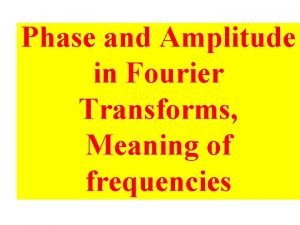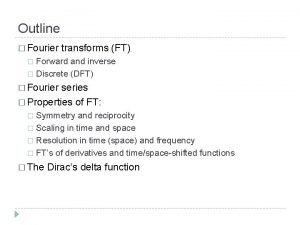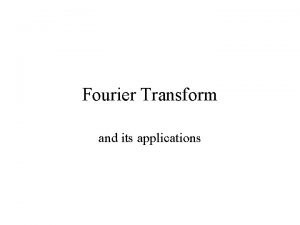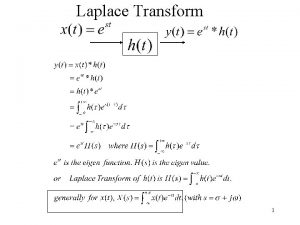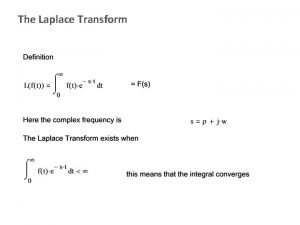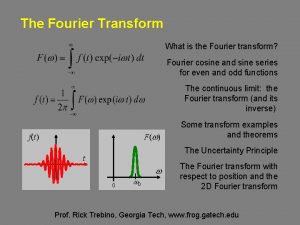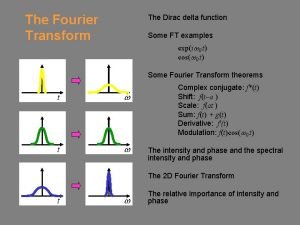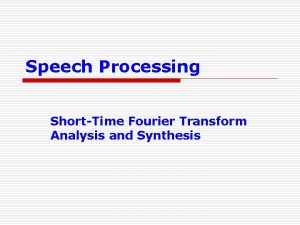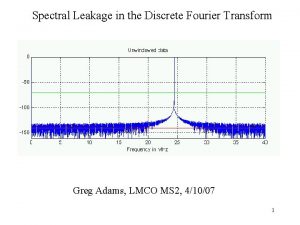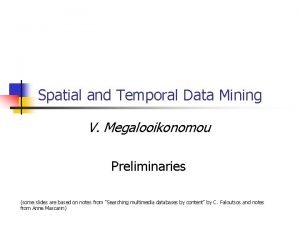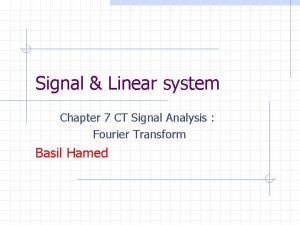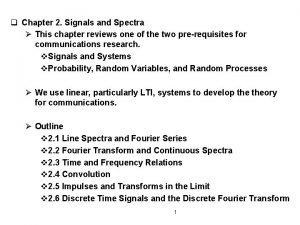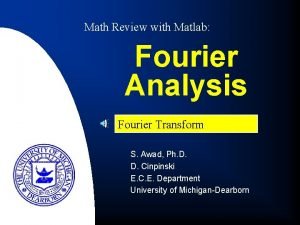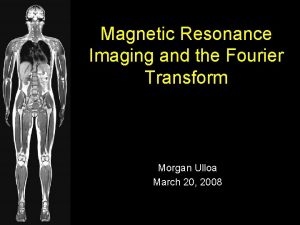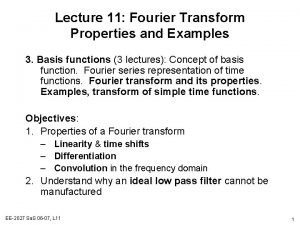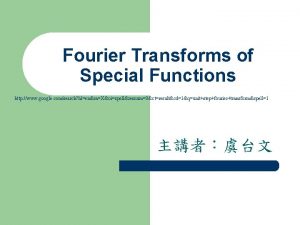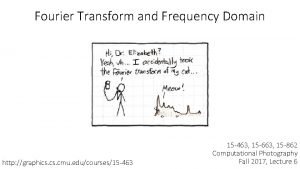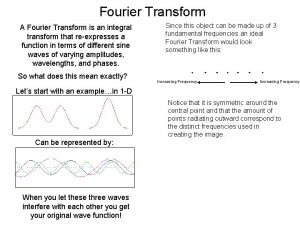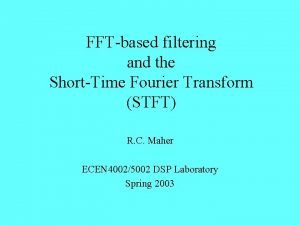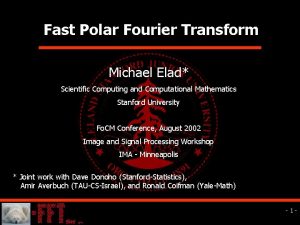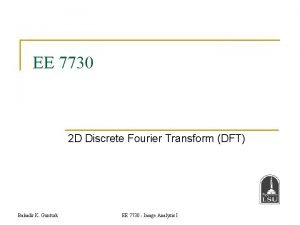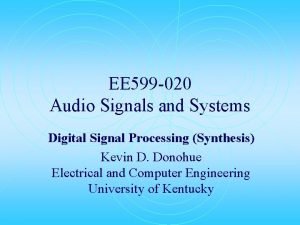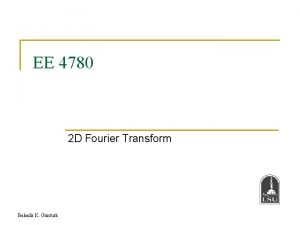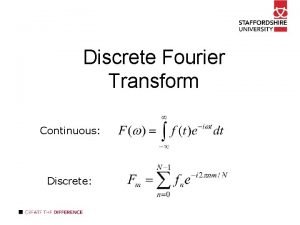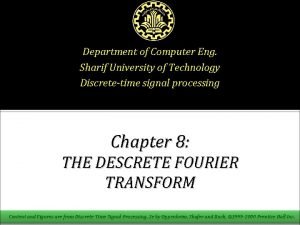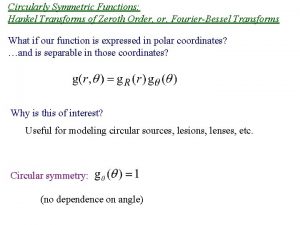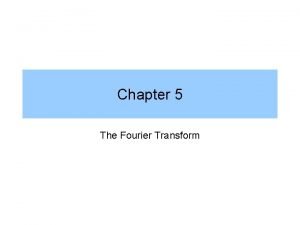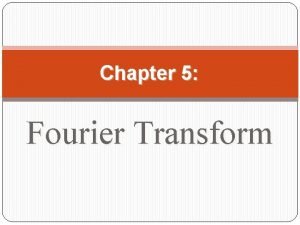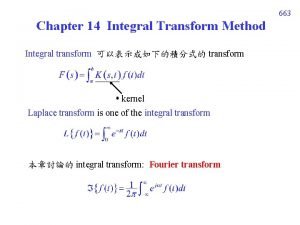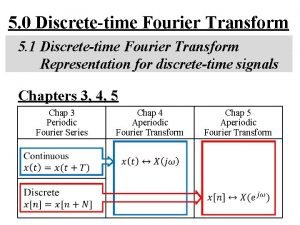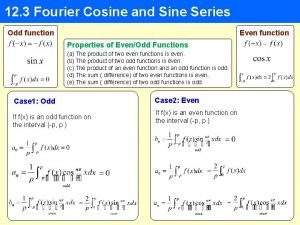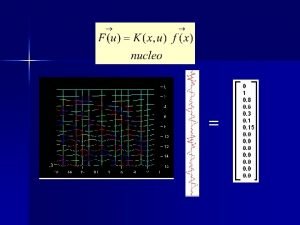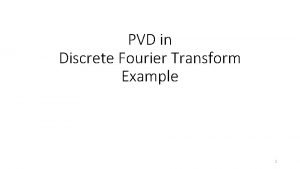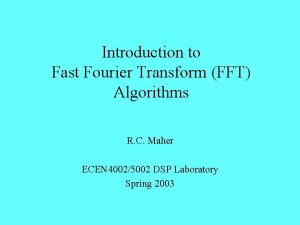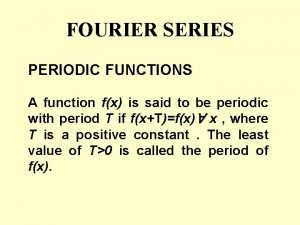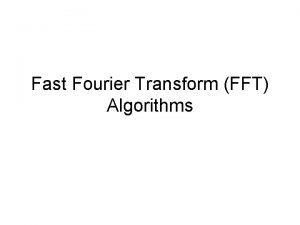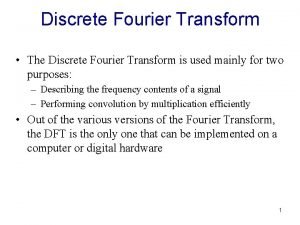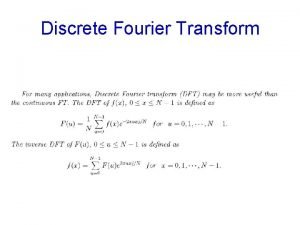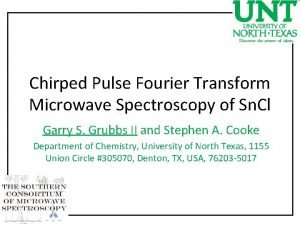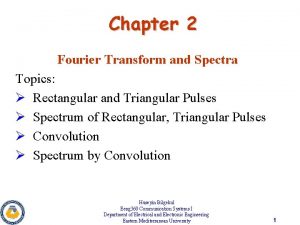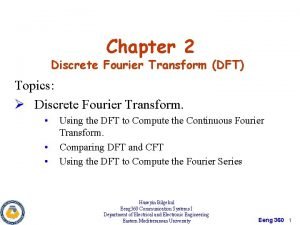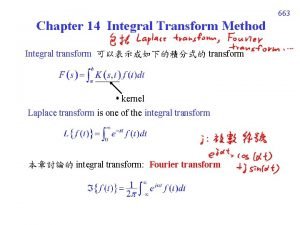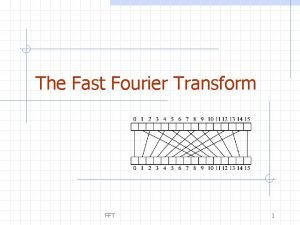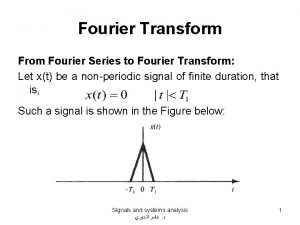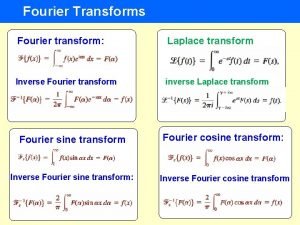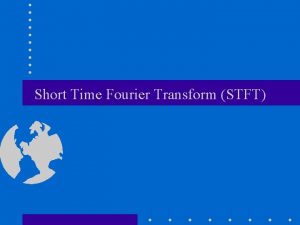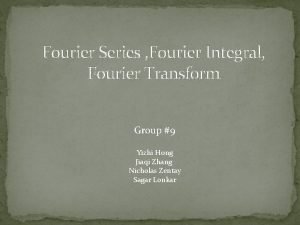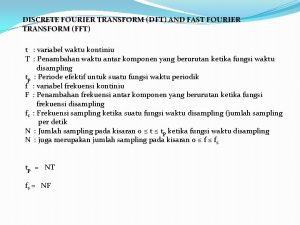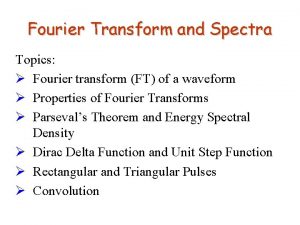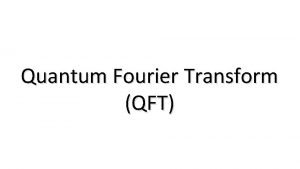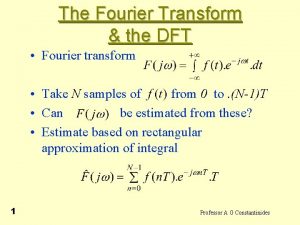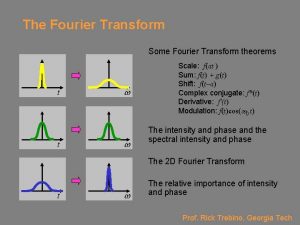Chapter 4 The Fourier Series and Fourier Transform























































- Slides: 55

Chapter 4 The Fourier Series and Fourier Transform

Fourier Series Representation of Periodic Signals • Let x(t) be a CT periodic signal with period T, i. e. , • Example: the rectangular pulse train

The Fourier Series • Then, x(t) can be expressed as where is the fundamental frequency (rad/sec) of the signal and is called the constant or dc component of x(t)

Dirichlet Conditions • A periodic signal x(t), has a Fourier series if it satisfies the following conditions: 1. x(t) is absolutely integrable over any period, namely 2. x(t) has only a finite number of maxima and minima over any period 3. x(t) has only a finite number of discontinuities over any period

Example: The Rectangular Pulse Train • From figure , so • Clearly x(t) satisfies the Dirichlet conditions and thus has a Fourier series representation

Example: The Rectangular Pulse Train – Cont’d

Trigonometric Fourier Series • By using Euler’s formula, we can rewrite as dc component k-th harmonic as long as x(t) is real • This expression is called the trigonometric Fourier series of x(t)

Example: Trigonometric Fourier Series of the Rectangular Pulse Train • The expression can be rewritten as

Gibbs Phenomenon • Given an odd positive integer N, define the N -th partial sum of the previous series • According to Fourier’s theorem, theorem it should be

Gibbs Phenomenon – Cont’d

Gibbs Phenomenon – Cont’d overshoot: overshoot about 9 % of the signal magnitude (present even if )

Parseval’s Theorem • Let x(t) be a periodic signal with period T • The average power P of the signal is defined as • Expressing the signal as it is also

Fourier Transform • We have seen that periodic signals can be represented with the Fourier series • Can aperiodic signals be analyzed in terms of frequency components? • Yes, and the Fourier transform provides the tool for this analysis • The major difference w. r. t. the line spectra of periodic signals is that the spectra of aperiodic signals are defined for all real values of the frequency variable not just for a discrete set of values

Frequency Content of the Rectangular Pulse

Frequency Content of the Rectangular Pulse – Cont’d • Since write where is periodic with period T, we can

Frequency Content of the Rectangular Pulse – Cont’d • What happens to the frequency components of as ? • For

Frequency Content of the Rectangular Pulse – Cont’d plots of vs. for

Frequency Content of the Rectangular Pulse – Cont’d • It can be easily shown that where

Fourier Transform of the Rectangular Pulse • The Fourier transform of the rectangular pulse x(t) is defined to be the limit of as , i. e. ,

The Fourier Transform in the General Case • Given a signal x(t), its Fourier transform is defined as • A signal x(t) is said to have a Fourier transform in the ordinary sense if the above integral converges

The Fourier Transform in the General Case – Cont’d • The integral does converge if 1. the signal x(t) is “well-behaved” well-behaved 2. and x(t) is absolutely integrable, integrable namely, • Note: well behaved means that the signal has a finite number of discontinuities, maxima, and minima within any finite time interval

Example: The DC or Constant Signal • Consider the signal • Clearly x(t) does not satisfy the first requirement since • Therefore, the constant signal does not have a Fourier transform in the ordinary sense • Later on, we’ll see that it has however a Fourier transform in a generalized sense

Example: The Exponential Signal • Consider the signal • Its Fourier transform is given by

Example: The Exponential Signal – Cont’d • If , does not exist • If , and does not exist either in the ordinary sense • If , it is amplitude spectrum phase spectrum

Example: Amplitude and Phase Spectra of the Exponential Signal

Rectangular Form of the Fourier Transform • Consider • Since in general is a complex function, by using Euler’s formula

Polar Form of the Fourier Transform • can be expressed in a polar form as where

Fourier Transform of Real-Valued Signals • If x(t) is real-valued, it is • Moreover whence Hermitian symmetry

Example: Fourier Transform of the Rectangular Pulse • Consider the even signal • It is

Example: Fourier Transform of the Rectangular Pulse – Cont’d

Example: Fourier Transform of the Rectangular Pulse – Cont’d amplitude spectrum phase spectrum

Bandlimited Signals • A signal x(t) is said to be bandlimited if its Fourier transform is zero for all where B is some positive number, called the bandwidth of the signal • It turns out that any bandlimited signal must have an infinite duration in time, i. e. , bandlimited signals cannot be time limited

Bandlimited Signals – Cont’d • If a signal x(t) is not bandlimited, it is said to have infinite bandwidth or an infinite spectrum • Time-limited signals cannot be bandlimited and thus all time-limited signals have infinite bandwidth • However, for any well-behaved signal x(t) it can be proven that whence it can be assumed that B being a convenient large number

Inverse Fourier Transform • Given a signal x(t) with Fourier transform , x(t) can be recomputed from by applying the inverse Fourier transform given by • Transform pair

Properties of the Fourier Transform • Linearity: • Left or Right Shift in Time: • Time Scaling:

Properties of the Fourier Transform • Time Reversal: • Multiplication by a Power of t: • Multiplication by a Complex Exponential:

Properties of the Fourier Transform • Multiplication by a Sinusoid (Modulation): • Differentiation in the Time Domain:

Properties of the Fourier Transform • Integration in the Time Domain: • Convolution in the Time Domain: • Multiplication in the Time Domain:

Properties of the Fourier Transform • Parseval’s Theorem: if • Duality:

Properties of the Fourier Transform Summary

Example: Linearity

Example: Time Shift

Example: Time Scaling time compression time expansion frequency compression

Example: Multiplication in Time

Example: Multiplication in Time – Cont’d

Example: Multiplication by a Sinusoid sinusoidal burst

Example: Multiplication by a Sinusoid – Cont’d

Example: Integration in the Time Domain

Example: Integration in the Time Domain – Cont’d • The Fourier transform of x(t) can be easily found to be • Now, by using the integration property, it is

Example: Integration in the Time Domain – Cont’d

Generalized Fourier Transform • Fourier transform of • Applying the duality property generalized Fourier transform of the constant signal

Generalized Fourier Transform of Sinusoidal Signals

Fourier Transform of Periodic Signals • Let x(t) be a periodic signal with period T; as such, it can be represented with its Fourier transform • Since , it is

Fourier Transform of the Unit-Step Function • Since using the integration property, it is

Common Fourier Transform Pairs
 Fourier transform amplitude and phase
Fourier transform amplitude and phase Inverse fourier transform
Inverse fourier transform The fourier transform and its applications
The fourier transform and its applications Relation between fourier and laplace transform
Relation between fourier and laplace transform Laplace table
Laplace table Inverse fourier transform
Inverse fourier transform Fourier transform of dirac delta function
Fourier transform of dirac delta function Ct ft
Ct ft Short time fourier transform applications
Short time fourier transform applications Dft table
Dft table Parseval's identity for fourier transform
Parseval's identity for fourier transform Fourier transform properties table
Fourier transform properties table Rayleigh energy theorem
Rayleigh energy theorem Fourier transform of ramp function
Fourier transform of ramp function Frequency
Frequency Fourier transform properties examples
Fourier transform properties examples Inverse fourier transform of unit step function
Inverse fourier transform of unit step function Fourier transform gaussian
Fourier transform gaussian Fourier transform definition
Fourier transform definition Inverse fourier transform table
Inverse fourier transform table Fourier transform convolution
Fourier transform convolution Sin(2pift)
Sin(2pift) Fourier transform formula
Fourier transform formula Fourier transform
Fourier transform Short time fourier transform
Short time fourier transform Polar fft
Polar fft Fourier transform of product of two functions
Fourier transform of product of two functions 2d discrete fourier transform
2d discrete fourier transform Sinc fourier transform
Sinc fourier transform 4780/2
4780/2 Discrete fourier transform
Discrete fourier transform Fourier transform of impulse train
Fourier transform of impulse train Fourier transform of circ function
Fourier transform of circ function Rect t/2
Rect t/2 Fourier transform is defined for
Fourier transform is defined for Parseval's equation
Parseval's equation Integral of unit step
Integral of unit step Fourier transform formula table
Fourier transform formula table Sine fourier transform
Sine fourier transform Duality of fourier transform
Duality of fourier transform Fourier transform odd function
Fourier transform odd function Windowed fourier transform
Windowed fourier transform Fourier transform
Fourier transform Integration of delta function
Integration of delta function Introduction to fast fourier transform
Introduction to fast fourier transform Fourier transform solver
Fourier transform solver Series de fourier
Series de fourier What is radix 2 fft
What is radix 2 fft What is dft
What is dft 2d discrete fourier transform
2d discrete fourier transform Chirped pulse fourier transform microwave spectroscopy
Chirped pulse fourier transform microwave spectroscopy Fourier transform of shifted rectangular pulse
Fourier transform of shifted rectangular pulse Dft
Dft Fourier transform pair
Fourier transform pair Fft integer multiplication
Fft integer multiplication Fourier transform of reciprocal function
Fourier transform of reciprocal function
